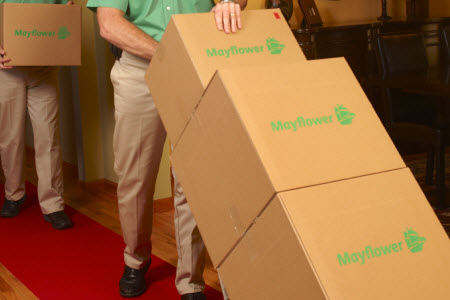Moving may be right down there with root canals in the nether regions of life’s bucket list. While the thought of nesting in a new home is exciting, the act of getting there is often stressful, exhausting, and expensive.
So to help your bottom line, we gathered these tips on how to save during your move without bribing your poor friends to help.
Use a piggyback service
Ghostruck is a service that lets a mover piggyback on another mover’s empty truck space for a flat rate.
Here’s how it works: Snap a photo of what you want moved and upload it to Ghostruck’s app or website. Type in when and where your stuff is going, then an algorithm will calculate the exact cost to transport it with licensed and insured movers. Customers can review their rate before they book, and while prices vary based on what you’re moving and where, it’s all but guaranteed to be at least one-third cheaper than renting a whole truck just for yourself.
Move during winter
Sure, a winter move may entail inclement weather and icy sidewalks. But it’ll also save you a bundle. The industry’s “dead season is the perfect time to get a deal on your moving quote,” says
Lior Rachmany, CEO of New York’s
Dumbo Moving + Storage.
While winter jobs may be generated at a better rate, Rachmany advises that during negotiation customers mention they’re aware it’s the slow season and that prices should be lower.
Another cash-saving tip? Avoid an end-of-month move, which “is like taking a taxi at rush hour—the moving companies are overwhelmed. Moving on off-peak days is cheaper.” Choose wisely!
Avoid guesstimates
Moving company estimates are just that, meaning your final bill could be way over your budget.
“A simple local move should be a guaranteed price,” says Rachmany—or, at most with a maximum cap if the hours go over so you know the most it could cost. “Avoid hourly estimates and even flat prices that seem too low. Lowballing is common in the moving industry.”
What about tipping, which can run from $10 to $50 per mover? “Tipping isn’t mandatory,” he says. When in doubt, ask the company beforehand about its policy.
Lighten your load
Moving is a time of reckoning. That fringed leather jacket you wore once? Yard sale! Or donate it to the
Salvation Army. Besides the emotional capital of doing good, charitable giving is tax-deductible—a working refrigerator could net you $250! You can find more savings in this
donation value guide.
Bonus: You’ll save on your moving costs by having less to move. According to Realtor®
Bill Golden, moving too much unnecessary stuff is a common lament of home buyers.
“They don’t do enough weeding out beforehand and end up jettisoning things they paid to move,” he says. Since it costs $3 to $5 per box to move locally, according to Rachmany, six boxes of old clothes that ultimately get tossed just cost you upward of $50.
Find free boxes
New boxes cost anywhere from $1 to $2 each, so look on
Boxcycle, where a used box can run as little as 15 cents. If even
that’s too much, go to
Freecycle to find a recent mover looking to get rid of boxes.
You could also save money
and the environment by “going green with
Rent-A-Green Box.” These plastic bins with lids run “half the cost of buying cardboard boxes. You don’t need to tape—simply pack, stack, and move,” says founder
Spencer T. Brown. Most companies drop off these bins and pick them up at the new location for free.
Break out your toolbox
“Take beds, tables, and wall units apart yourself and put them back together” after the move, says Rachmany. “Because fewer services are required of the movers, you’ll save on your rate or duration of the move. If you’re taking your bed and furniture apart to reassemble them upon delivery, it should take off about 10 to 15% of the total price.”
Keep all your receipts
You can claim moving expenses on your tax return within one year of starting a new job that’s more than 50 miles from your old home, even if you didn’t have that job lined up before moving. Eligible expenses include moving and storage costs as well as monies spent packing, transporting, and insuring your personal property.








